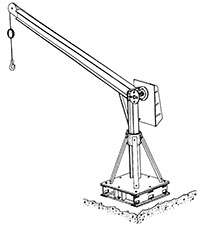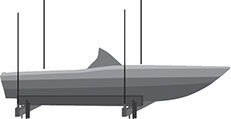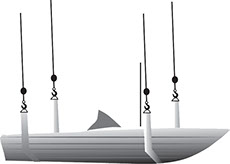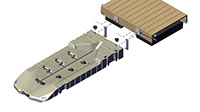
Boat Lift Alternatives
By far, most boaters choose to trailer their boats, rather than keep them in a slip … for a number of reasons. Obviously, wet or dry slip storage is expensive, yet provides easy access to the water while avoiding the stress and strain of boat access areas as well as all that backward maneuvering which can be a challenge. For those privileged to live on the water, the personal boat slip can become a requirement of that lifestyle.
Assuming a decision in favor of wet slips, whether out the back door or in your favorite marina, then comes the decisions regarding boat lifts: yes or no. Obviously, they’re not free so you start by considering pros and cons. So why a lift?
Lift companies will tell you the device will pay for itself over time, mostly in reduced maintenance. Given the quick and easy access to the water lifts provide, the pay-back in terms
of enjoyment of the boating exper-
ience begins to reduce the sting
of the expense of buying and
installing the lift equipment.
Beyond that instant gratification, though, there is some real truth to
the reduced boat care and main-
tenance lifts can provide. To
begin with, eighty-five percent
of boats that sink, sink at the dock. Usually the culprit is a dead battery or a failed bilge pump which allows the docked vessel to take on water. Unattended, a boat can sink in short order. On a lift, out of the water, that extreme circumstance is avoided.
Somewhat less extreme, but still a cost factor, is the cleaning your boat requires. Boats that spend most of their time tied up in a slip will accumulate algae, if nothing else. Algae growth on the gel-coat of your hull can permanently stain the boat, reducing its resale value. Also, algae growth can easily reduce your top speed by 10 mph and it will greatly reduce your gas mileage. Going green shouldn’t mean your hull should be that color.
Of course, boaters will still want some level of cleaning and detailing, whether that’s accomplishing by enlisting the children or by hiring professionals – even if the boat is stored on a lift. Over time, the cleaning and detailing expense is reduced by storing your boat on a lift.
Keeping a boat in the water more-or-less full time is the primary cause of hull blisters, too. Long term, it’s hard to completely avoid work on your bottom paint and gel-coat, but storing your boat above the water-line will help keep those expenses to a minimum.
So the boat on the lift, out of the water, will not only look better (And looking good is a big part of the boat experience, no?), it will operate more efficiently and save on fuel expense.
Now, assuming the checkbook has agreed, it’s time to shop for just the right device, and they are legion. Lifts have been a part of boating for many, many years. Their original design copied the equipment used to move heavy supplies and equipment in construction and on docks. Think, too, about lifeboats aboard large ships.
Like that equipment of yore, early boat lifts were davit lifts, usually mounted on pilings or set in the ground above a seawall. With a fore and aft cable, they were connected to lifting eyes on the watercraft. The old style davit was not easy to operate and, since the mid-1970’s, lift technology has expanded options to address a wide variety of lifting environments and an even wider range of budgeting realities. Davits are still in use, but primarily in small watercraft applications.
Today, there are two basic kinds of lifts: standing and floating. Standing lifts are fixed to a structure like a dock or seawall, while a floating lift is generally attached to a dock. A floating lift generates lift by inflating tanks or cushions which raise your boat out of the water. Other floating lifts include drive-on, floating platforms.
Most manufacturers make several kinds of lifts for varying conditions, as well as numerous models to handle differing lift requirements.

Piling Mounted Davits

STANDING LIFTS
Davit & Cantilever Lifts
Standing lifts include davit (mentioned above) and cantilever lifts, which trace their origins largely to construction or freight applications, lifting heavy loads. Davits and cantilever lifts are commonly used today as a boat lift mechanism for smaller boats, primarily in coastal environments. A great advantage of these lifts is that no lift equipment resides below the waterline. Typically, davit and cantilever lifts can be dock-, seawall- or pile-mounted.
Swinger Lifts
Swinger lifts rotate 180-degrees so a watercraft can be lifted from the water to a dock, then swing around so the watercraft is stored right on the dock. This type of lift is ideal for PWC’s and small boats. An advantage to the swinger lift, like the davits and cantilevers, is that no equipment resides below the waterline. The swinging feature also allows for easier cleaning and maintenance of the watercraft. Also like davits and cantilevers, these lifts can be configured for manual or electric operation.
Davit
Gear & Chain Lifts
Gear-driven and chain lifts are hybrids of the cradle lift systems, using their respective movement devices to haul boats out of the water. Typically characterized by solid construction, these lifts offer substantial protection for the supported boat.
Competitive hyperbole will convey visions of broken gears or snapped cables. The fact is, anything mechanical, especially on the water, is prone to corrosion and wear. As with a boat, regular inspection and maintenance should prevent most difficulties.
Elevator Lifts
Traditional lifts were impossible to install on waterfronts where outboard pilings are not allowed (like narrow canals), or where bottom conditions make pile-driving difficult.
Hydraulic Lift
FLOATING LIFTS
Floating lifts run the gamut from giant drive-on pillows to inflatable tanks to drive-on platforms. Floating lifts achieve many of the same goals as standing lifts, primarily lifting boats out of the water. Because they float, the lift and lifted boat are subject to wave and wind action. Typically, these lifts are simpler mechanically than standing lifts, and easier to install.
As you can see, there are lifts for nearly every application and budget, and all manufacturers have a product line to address most situations. On the Piedmont lakes, lifts tend to be chain or gear-driven cradles or inflatable, but you can find a little of everything. Regardless of the type of lift you think you have to have, it’s always best to trust the professional. Sure, do your homework, but check references and consult with a reliable dock builder or lift retailer. You’ll find most local operations listed in the Piedmont Lakes Pilot Service Index. See the “Boat Lift” and “Dock Builder” categories. h




Sling Lifts
Sling lifts are among the least expensive of boat lifts and are usually employed inside boathouses. They consist of heavy lifting straps, weighted to submerge, drawn by cables on a winder which is attached to an overhead structure. Marine Travelifts used in boatyards also employ slings for raising and lowering vessels in for repair.
The advantages of sling lifts in ordinary boat lift applications are the minimal expense and the absence of equipment below the waterline. Improperly used, the sling can distort a boats rub-rail. Slings, by their nature, are also less substantial and provide less support and protection than other types of lifts. Sling lifts are available from a number of on-line retails.
Cradle Lifts
Cradle lifts, as the name implies, are mechanisms that cradle a boat, firmly holding the vessel in position. Most boat lifts employ some kind of cradling mechanism, but the term applies to particular lift styles as well. Primarily used in coastal environments, cradle lifts are characterized by cradle bunks fixed to crossbeams. The crossbeams are attached via cables to piling-mounted beams and the cables are driven to raise and lower the vessel.
There are also beamless models with winders on each of four pilings to raise and lower the lift cradle, rather than having the winders supported by an upper beam. Beamless lifts are popular, particularly in the mid-Atlantic region, because they allow unobstructed access to the vessel. Once again, the advantages of cradle lifts include the absence of equipment fixed below the waterline and the substantial nature of the lift construction.
Hydraulic Lifts
Hydraulic pistons push and pull, so hydraulic boat lifts hide below the boat, under the waterline. Beside the aesthetic advantages, this lift mechanism allows the boat to be positioned with less gap between boat and dock.
Especially attractive for boaters with little patience, hydraulic lifts generally operate faster and eliminate wait time. Additionally, operating noise is minimal.

The challenge presented by these circumstances lead to the development of the elevator lift. These lifts utilize a cable-drawn platform with wheels that ride on a vertical or near-vertical beam. Resting on the bottom, this beam supports the lift, eliminating the need for pilings.
Just as davit and cantilever lifts were patterned after industrial lifts, so too is the elevator lift, which works much the same way as industrial forklifts.
The lift accomplishes its mission, hauling the vessel well out of the water, but does rely on supporting structure below the waterline, where it is more susceptible to corrosion.
4 Point Cradle lift
4 Point Sling lift
EZ-Port Personal Watercraft Floating Lift
Side Mounted Elevator Lift
ABOUT PILOT MEDIA
Copyright © 2018 Pilot Media II LLC

